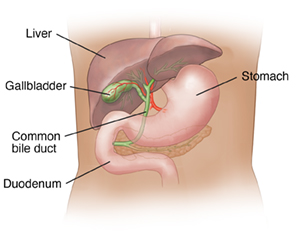How the Liver Works
Anatomy of the liver
The liver is located in the upper right-hand part of the abdominal cavity. It's under the diaphragm and on top of the stomach, right kidney, and intestines. The liver is a dark reddish-brown, triangle-shaped organ that weighs about 3 pounds. The liver has many functions.
There are 2 distinct sources that supply blood to the liver:
The liver holds about 1 pint (13%) of the body's blood supply at any given moment. The liver has 2 main parts (lobes). Both of these are made up of 8 segments that consist of a thousand small lobes (lobules). These lobules are connected to small tubes (ducts) that connect with larger ducts from the common hepatic duct. The common hepatic duct transports the bile made by the liver cells to the gallbladder and the first part of the small intestine (duodenum). It does this through the common bile duct. Bile is a clear green or yellow fluid that helps break down the food you eat.

Functions of the liver
The liver regulates most chemical levels in the blood and excretes a product called bile. This helps carry away waste products from the liver. All of the blood leaving the stomach and intestines passes through the liver. The liver processes this blood. It breaks down, balances, and creates the nutrients. It also breaks down medicines into forms that are easier for the rest of the body to use. More than 500 vital functions have been identified with the liver. Some of the more well-known functions include:
-
Production of bile. This helps carry away waste and break down fats in the small intestine during digestion.
-
Production of certain proteins for blood plasma
-
Production of cholesterol and special proteins to help carry fats through the body
-
Conversion of excess glucose into glycogen for storage (This glycogen can later be converted back to glucose for energy.)
-
Balancing and production of glucose as needed
-
Regulation of blood levels of amino acids. These form the building blocks of proteins.
-
Processing of hemoglobin for distribution of its iron content (The liver stores iron.)
-
Conversion of poisonous ammonia to urea (Urea is one of the end products of protein metabolism that is excreted in the urine.)
-
Clearing the blood of drugs and other toxic substances
-
Regulating blood clotting
-
Resisting infections by making immune factors and removing certain bacteria from the bloodstream
-
Clearance of bilirubin. An accumulation of bilirubin will turn the skin and eyes yellow.
When the liver has broken down harmful substances, their by-products are excreted into the bile or blood. Bile by-products enter the intestine. They leave the body in stool. Blood by-products are filtered out by the kidneys and leave the body as urine.
Online Medical Reviewer:
Donna Freeborn PhD CNM FNP
Online Medical Reviewer:
Jen Lehrer MD
Online Medical Reviewer:
Raymond Kent Turley BSN MSN RN
Date Last Reviewed:
3/1/2023
© 2000-2025 The StayWell Company, LLC. All rights reserved. This information is not intended as a substitute for professional medical care. Always follow your healthcare professional's instructions.